The Death Of The White House Press Briefing And Trump’s Lack Of Transparency
The White House has succeeded in killing, for now, the White House Daily Press Briefing and in making itself the least transparent Administration in recent history.
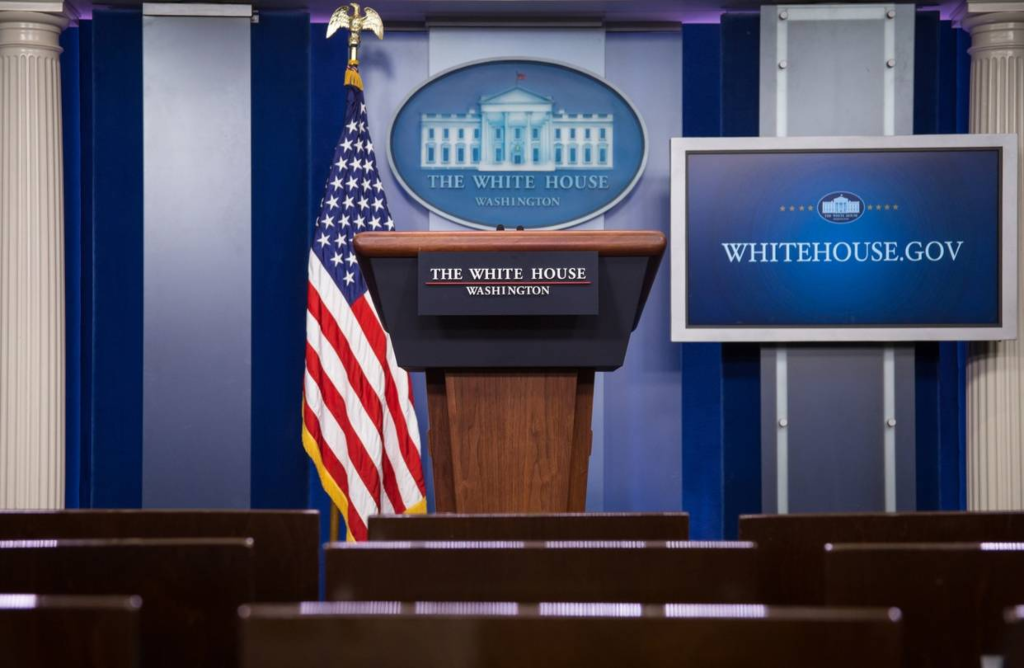
It’s been 87 days since Stephanie Grisham took over as White House Press Secretary from Sarah Huckabee Sanders. As of that day, it had been 113 days since the last White House Press Briefing, an event which used to take place virtually every day and had become increasingly rare in the Trump Administration. There has not been a single briefing since Grisham took over, bringing the total as of today to 200 days, and Grisham is making it clear that she’s unlikely to resurrect the practice:
White House press secretary Stephanie Grisham said Monday that she is not likely to conduct a White House press briefing anytime in the near future, deriding the once-regular sessions as an act of “theater” for reporters seeking “to get famous” during the televised news conferences.
“Not right now,” Grisham told the hosts of “Fox & Friends,” when asked whether the White House will resume its daily press briefing, a longstanding practice under President Donald Trump’s predecessors.
“I mean, ultimately, if the president decides that it’s something we should do, we can do that, but right now he’s doing just fine,” she continued. “And to be honest, the briefings have become a lot of theater. And I think that a lot of reporters were doing it to get famous. I mean, yeah, they’re writing books now. I mean, they’re all getting famous off of this presidency. And so, I think it’s great what we’re doing now.”
Grisham, who has rarely participated in on-camera interviews since becoming press secretary in June, praised her boss as “his own best spokesperson” and claimed he is “the most accessible president in history, as all of the media knows” — citing Trump’s frequent informal gaggles with the White House press corps.
Grisham also suggested that reporters’ criticisms of the president’s previous press secretaries, Sean Spicer and Sarah Huckabee Sanders, played a role in Trump’s decision to discontinue the briefings.
“I think that it’s so important that, you know, the spokesperson for the president can adequately speak to his policies and get his message out there, and I think the president saw that that’s not what was happening,” she said. “It had become, again, theater, and they weren’t being good to his people. And he doesn’t like that. He’s very loyal to his people, and he put a stop to it.”
Spicer was widely mocked for his combative and sometimes stumbling performances during the daily White House news briefings, which memorably became a subject of parody by actress Melissa McCarthy on “Saturday Night Live.”
Sanders oversaw the end of the daily briefings amid mounting questions from journalists regarding her credibility. She opted to develop a regular presence on cable news programs, especially “Fox & Friends,” where she would bludgeon the president’s detractors
Grisham went on to say that the press briefing is unnecessary because President Trump has become the most accessible President in history:
White House press secretary Stephanie Grisham on Monday defended the lack of daily news briefings, arguing that President Trump “is the most accessible president in history.”
“He’s his own best spokesperson,” Grisham said of the president during an interview on “Fox & Friends.” “And he’s the most accessible president in history as all of the media knows. Just yesterday, he gaggled two or three times with the press.”
A White House press secretary has not conducted a formal briefing with reporters since March. Trump, however, regularly conducts “chopper talks” while exiting the White House on his way to board Marine One on the South Lawn. Those gaggles can last anywhere from a few minutes to a half hour.
“To be honest, the briefings have become a lot of theatre,” Grisham said Monday. “And I think that a lot of reporters were doing it to get famous. They’re writing books now. They’re all getting famous off of this presidency, and so I think it’s great what we’re doing now.”
From day one, it has been clear that press briefings under the Trump Administration were going to be far different from what we saw under previous Administration dating back to at least the Nixon Administration. Primarily, of course, there was the signal sent on the very first full day of the Trump Administration when Sean Spicer used the podium of the Brady Press Briefing Room to lie on behalf of the President about the seemingly inconsequential issue of the size of the crowd on Inauguration Day. Instead of the often intense back-and-forth between members of the White House Press Corps and the Press Secretary or their Deputy, many of which would last a considerable period of time, the briefings conducted by Sarah Huckabee Sanders and her Deputy Raj Shah, and before them by Sean Spicer, gradually became shorter and less informative at the same time that they became more vitriolic. They also became less frequent. By the time Spicer left office in July 2017, it was unusual if there was more than one such briefing every two weeks. While that pace increased somewhat when Sarah Sanders took over, it quickly went back to to what Spicer had established as the new normal and, not long after that, became even less and less frequent. Additionally, the briefings have become less frequent. At this time last year, for example, there was nearly a month-long period during which Spicer, who had yet to be dismissed, did not conduct public briefings at all, instead preferring to deal with the press in off-camera, and sometimes off-the-record, press gaggles where reporters get a short period of time to answer questions.
Sanders became quite adept in finding ways to shorten the length of time she has to stand before the podium answer questions. One method has been to bring other members of the Administration before the Administration to the briefing, including Cabinet members, and have them announce some new policy initiative and answer press questions. This means that she had a convenient excuse for cutting short the length of her own portion of the briefing. Additionally, Sanders made a habit of essentially ignoring follow-up questions and failing to call on reporters who have gained a reputation for asking tough questions, such as CNN’s Jim Acosta. Instead, she called on reporters from foreign news organizations, who tend to ask questions of concern to their country of origin, or from one of the “friendly” news organizations that have gained credentials since the Trump Administration took office, such as the One America News Network, a conservative outlet that has gained prominence during the Trump Era. Finally, as noted in the linked article, Sanders adopted the habit of scheduling the briefing just before some other significant White House event that the press will be covering, thus giving her an excuse to cut the briefing short. On such days, the briefing ended up being as short as fifteen minutes during which she answers, at most, four or five questions.
In response to all of this one could say, I suppose, that the White House Press Briefing has always been of dubious value. It typically comes down to little more than a contest where the press tries to ask questions and the person at the podium pretends to answer them and usually only becomes relevant and newsworthy when there’s some story in the news in which the response from the White House plays an important role. As a general rule, though, this isn’t usually the case and I’ve often questioned why the cable networks have felt compelled to cover it live seemingly every day of the Trump Administration. I don’t recall this being a common practice during the Obama or previous Administrations except when there was some item in the news on which one would expect a response from the White House. Instead, the briefing would usually be covered on one of the iterations of C-Span and the networks would show relevant excerpts, if there were any, afterward. Given the fact that Sanders has made the briefings less and less informative as time has gone on, one wonders why the networks still cover them at all.
If nothing else, what we have seen happen to the press briefing is emblematic of what has happened with the Trump Administration overall. Slowly but surely, this has become one of the least transparent in the modern era. As noted above, it has been more than 700 days since the President last held a full and formal press conference. In its place, we’ve gotten joint conferences with visiting foreign leaders during which questions are limited and only granted to pre-selected journalists, press pool photo opportunities in which reporters shout questions at the President while he answers only what he chooses to answer, and short exchanges on the White House South Lawn as Marine One’s engines roar in the background awaiting the President’s imminent departure. The result has been that the White House has become more closed-off than any recent memory. Indeed, if it weren’t for all of the people inside the White House leaking to the press, a practice that has continued despite numerous departures, we’d know almost nothing about what is going on in the White House outside of the official talking points delivered by the White House. It appears that’s exactly what the President wants.
Perhaps the next Administration, whether it takes power in 2021 or 2024, will resurrect the daily press briefing and other practices aimed at transparency that this President has closed down. Until then, though, both of them appear to be dead.

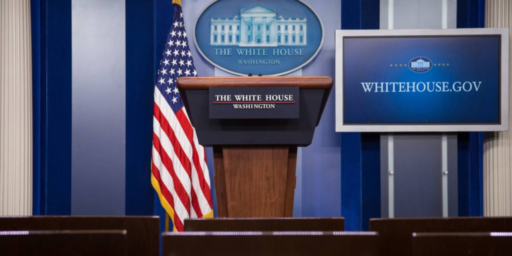
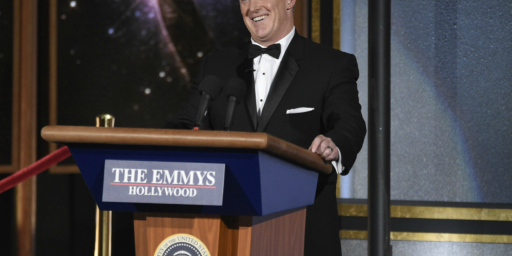
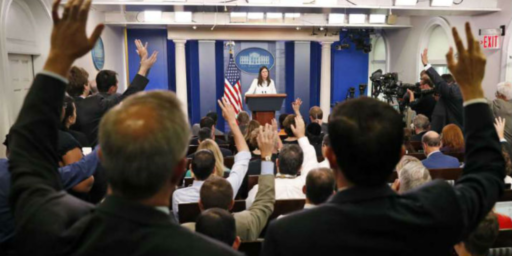
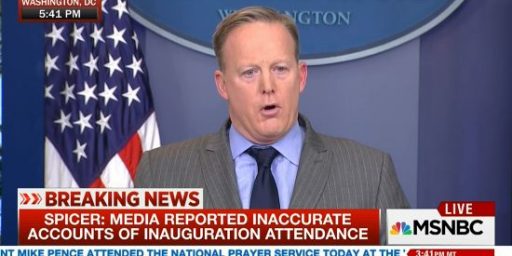
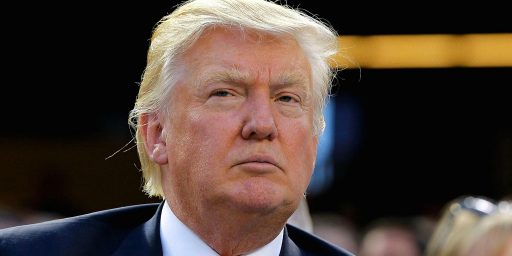
Why bother with a press office at all when you’ve got Fox News?
This discussion is like finding a toddler driving a car on the highway and tut-tutting over their failure to use turn signals. A press briefing implies that there are meaningful policies or initiatives to communicate and that gaps in understanding can be repaired with a few back and forth questions until you reach clarity. Trump simply does not have the the mental capacity to have policies. The failure to understand his ramblings cannot be rectified by explanations because there is no meaningful content to explain.
I’ve said from the first time he tossed his hat in the ring that the most important thing to realize about Trump is that he is a profoundly stupid person. He doesn’t even have the animal cunning that allows some stupid but vicious people to survive. His income comes from two sources: those who find him a useful idiot in furtherance of their own schemes, and those pathetic souls so unsophisticated and in need of validation that they sign up for the blatantly corrupt schemes his employees come up with on his behalf.
I can’t imagine why anyone would still think he has any kind of intelligence at all but all the proof you need is this latest Ukraine thing. Set aside the fact that it is an immoral, faithless, sellout of our country. He did it in such an inept way that even if the Ukraine had been willing to go along he backed them into a corner so they would have had their fingerprints all over it and been crucified by the US at the next change in administration. He came up with this harebrained scheme in his tiny animalistic brain and sent Rudy Giuliani off on a barn storming mission. Giuliani couldn’t have been more noticeable running through church naked. Then, to top it off, Trump blatantly tried to blackmail the Ukrainian government with witnesses on the line. Someone with even moderate intelligence could have done it in such a way that the Ukrainians got the message without leaving fingerprints, and given them room to comply without seeming to do a corrupt President’s bidding. But Trump isn’t moderately intelligent. He’s not even minimally intelligent. He’s quite simply a moron.
What the heck is a press secretary supposed to do with that?
Why would Trump want people asking about what he’s doing?
I’m old enough to remember the comic strip Doonesbury during the Watergate years. One of the most effective visuals that Garry Trudeau used was the gradual growth of a brick wall around the White House, over many weeks of daily strips. Trump didn’t bother with that; he put the wall up himself, all at once, preemptively.
@DrDaveT: Well, he “built the wall,” then, didn’t
he? That ought to make the cult happy.
It sounds like she’s saying Trump should get a cut of the book revenues.
@Gustopher: Trump loves, loves, loves suing writers. To quote him on the subject: “It costs me a few dollars and bankrupts them.”
Trumpian speech has three modes: threaten, boast, and complain.
He has no information mode.
One of the things that Trump will be remembered for, and be a lesson for the future, will be his war on journalism.
“Fake news”, utter lack of press briefings, and the sheer totalalitarian gall of “enemy of the people”.
This is third world, banana republic crap.